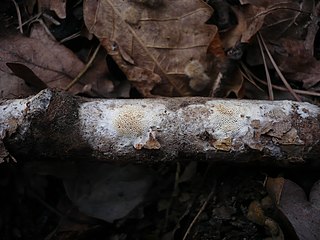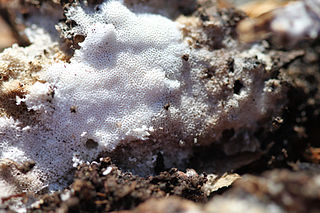Related Research Articles

The Polyporales are an order of about 1800 species of fungi in the division Basidiomycota. The order includes some polypores as well as many corticioid fungi and a few agarics. Many species within the order are saprotrophic, most of them wood-rotters. Some genera, such as Ganoderma and Fomes, contain species that attack living tissues and then continue to degrade the wood of their dead hosts. Those of economic importance include several important pathogens of trees and a few species that cause damage by rotting structural timber. Some of the Polyporales are commercially cultivated and marketed for use as food items or in traditional Chinese medicine.
Abundisporus is a small genus of poroid fungi currently with seven recognized species. They differ from other polypores in having coloured rather than hyaline spores.

The Meruliaceae are a family of fungi in the order Polyporales. According to a 2008 estimate, the family contains 47 genera and 420 species. As of April 2018, Index Fungorum accepts 645 species in the family.

The Steccherinaceae are a family of about 200 species of fungi in the order Polyporales. It includes crust-like, toothed, and poroid species that cause a white rot in dead wood.

Ceriporiopsis is a genus of fungi in the family Phanerochaetaceae. The genus is widely distributed, and, according to a 2008 estimate, contains about 25 species. Ceriporiopsis was circumscribed in 1963 by Polish mycologist Stanislaw Domanski. The genus is a wastebasket taxon, containing "species that share common macroscopic and microscopic characteristics, but are not necessarily related." Ceriporiopsis species are crust fungi that cause a white rot. They have a monomitic hyphal system, containing only generative hyphae, and these hyphae have clamp connections.

Antrodiella is a genus of fungi in the family Steccherinaceae of the order Polyporales.

Irpex is a genus of corticioid fungi in the order Polyporales. Species produce fruit bodies that grow as a crust on the surface of dead hardwoods. The crust features an irpicioid spore-bearing surface, meaning it has irregular and flattened teeth. Irpex is distinguished from the similar genera Junghuhnia and Steccherinum by the simple septa found in the generative hyphae.

Mycorrhaphium is a genus of fungi in the family Steccherinaceae. The genus was circumscribed by Dutch mycologist Rudolph Arnold Maas Geesteranus in 1962. The type species is Mycorrhaphium adustum. Fruit bodies of species in the genus have caps, stipes, and a hydnoid (tooth-like) hymenophore. There is a dimitic hyphal system, where the skeletal hyphae are found only in the tissue of the "teeth", and a lack of cystidia. The spores are smooth, hyaline (translucent), and inamyloid.

Nigroporus is a genus of poroid fungi in the family Steccherinaceae. The genus was circumscribed by American mycologist William Alphonso Murrill in 1905. Nigroporus has a pantropical distribution. The genus name combines the Latin word niger ("black") with the Ancient Greek word πόρος ("pore").

Skeletocutis is a genus of about 40 species of poroid fungi in the family Polyporaceae. The genus has a cosmopolitan distribution, although most species are found in the Northern Hemisphere. It causes a white rot in a diverse array of woody substrates, and the fruit bodies grow as a crust on the surface of the decaying wood. Sometimes the edges of the crust are turned outward to form rudimentary bracket-like caps.

Tyromyces is a genus of poroid fungi in the family Polyporaceae. It was circumscribed by mycologist Petter Karsten in 1881. The type species is the widely distributed Tyromyces chioneus, commonly known as the white cheese polypore. The phylogenetic position of Tyromyces within the Polyporales is uncertain, but it appears that it does not belong to the "core polyporoid clade". Tyromyces is polyphyletic as it is currently circumscribed, and has been described as "a dumping place for monomitic white-rot species with thin-walled spores."
Antella is a genus of three species of crust fungi in the family Steccherinaceae.
Atraporiella is a monotypic fungal genus in the family Steccherinaceae. It contains the crust fungus Atraporiella neotropica, known only from Belize.
Sebipora is a fungal genus in the family Gelatoporiaceae. It was circumscribed in 2012 by mycologist Otto Miettinen to contain the crust fungus Sebipora aquosa, its single species. This fungus is found in low altitudes in Sumatra and New Guinea, where it causes a white rot on dead angiosperm wood, particularly fallen tree trunks, and frequently on burned wood.

Metuloidea is a genus of five species of fungi in the family Steccherinaceae. The genus was circumscribed by New Zealand-based mycologist Gordon Herriot Cunningham in 1965. The type species is M. tawa, a fungus originally described by Cunningham as a species of Trametes. Formerly classified in family Meruliaceae, Metuloidea was moved to the Steccherinaceae in 2016, following prior research that outlined a revised framework for the Steccherinaceae based on molecular phylogenetics.

The Gelatoporiaceae are a small family of crust fungi in the order Polyporales. The family was circumscribed in 2017 by mycologists Otto Miettinen, Alfredo Justo and David Hibbett to contain the type genus Gelatoporia and three other related genera, Cinereomyces, Obba, and Sebipora.
Butyrea is a genus of two species of crust fungi in the family Steccherinaceae.
Metuloidea cinnamomea is a species of tooth fungus in the family Steccherinaceae. Found in the Andes region of Venezuela, it was initially described in 2010 by Teresa Iturriaga and Leif Ryvarden as a species of Antrodiella. Otto Miettinen and Ryvarden transferred it to the newly created genus Metuloidea in 2016.
Trulla dentipora is a neotropical polypore fungus in the family Steccherinaceae, and the type species of the genus Trulla. Characteristics of this species are the irregularly shaped pores with jagged or teeth-like edges, and the sausage-shaped spores. Found in Venezuela, the fungus was originally described by mycologists Leif Ryvarden and Teresa Iturriaga in 2004 as a species of Antrodiella. The type was collected in Henri Pittier National Park, where it was found growing on a hardwood log. Ryvarden and Otto Miettinen transferred the fungus to the newly created Trulla in 2016.
Antella niemelaei is a species of poroid crust fungus in the family Steccherinaceae.
References
- ↑ Miettinen, Otto; Larsson, Ellen; Sjökvist, Elisabet; Larsson, Karl-Henrik (2012). "Comprehensive taxon sampling reveals unaccounted diversity and morphological plasticity in a group of dimitic polypores (Polyporales, Basidiomycota)". Cladistics. 28 (3): 251–270. doi:10.1111/j.1096-0031.2011.00380.x. S2CID 84643554.
- 1 2 3 4 Miettinen, Otto; Ryvarden, Leif (2016). "Polypore genera Antella, Austeria, Butyrea, Citripora, Metuloidea and Trulla (Steccherinaceae, Polyporales)". Annales Botanici Fennici. 53 (3–4): 157–172. doi:10.5735/085.053.0403. S2CID 84739655.